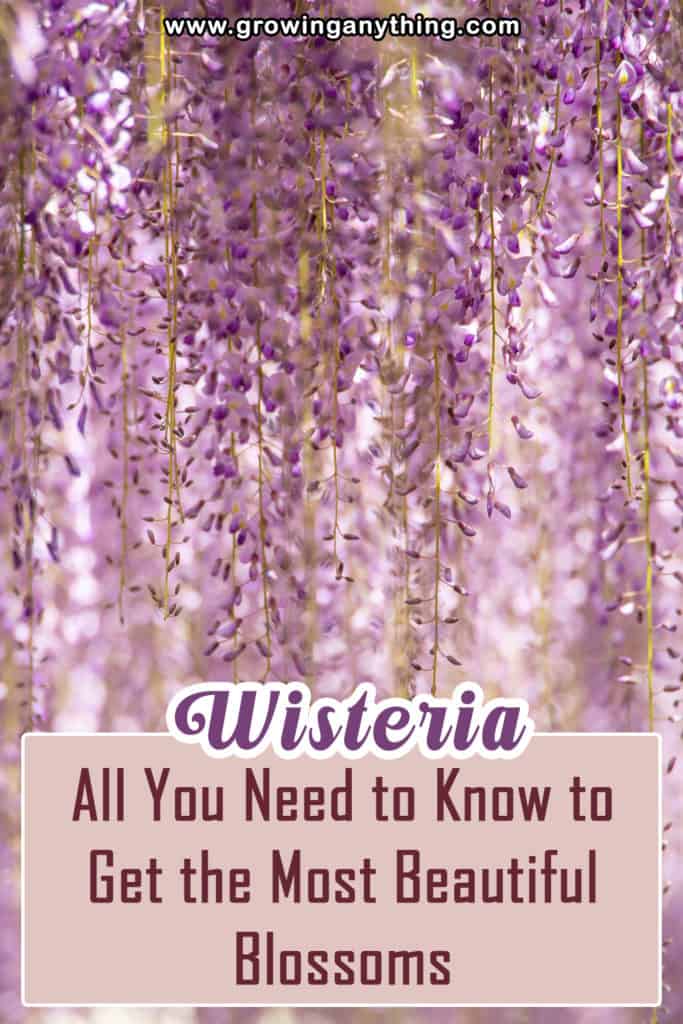All About Wisteria
When Wisteria blossoms, it creates a magical landscape and is enough to make you want it in your backyard. But, making the Wisteria produce flowers every year is a complex task. Other than persistency, there are skills and knowledge applied behind the most beautiful Wisteria blooms.
In this article, you will learn everything it takes to grow healthy Wisteria and make it bloom! You will also discover how to distinguish between Wisteria species and more tips on growing them.
Also, I will share useful and inspirational Wisteria decoration ideas.
But, before we move on to the growing tips, let’s learn more about the plant itself and what it symbolizes.
What Kind of Plant is Wisteria?
Wisteria belongs to the legume family Fabaceae and it is a beautiful flowering plant. It grows into specific woody and climbing vines. Interestingly, the plant climbs by twining the stems around the support nearby. For example, when you look at some species from above, you can notice that the plant twins the stems counterclockwise.
Wisteria can climb high above the ground, up to 66 feet, but spreads about half of that in width.
Wisteria is native to Japan, Korea, China, and East USA.
It is grown mostly as an ornamental plant.
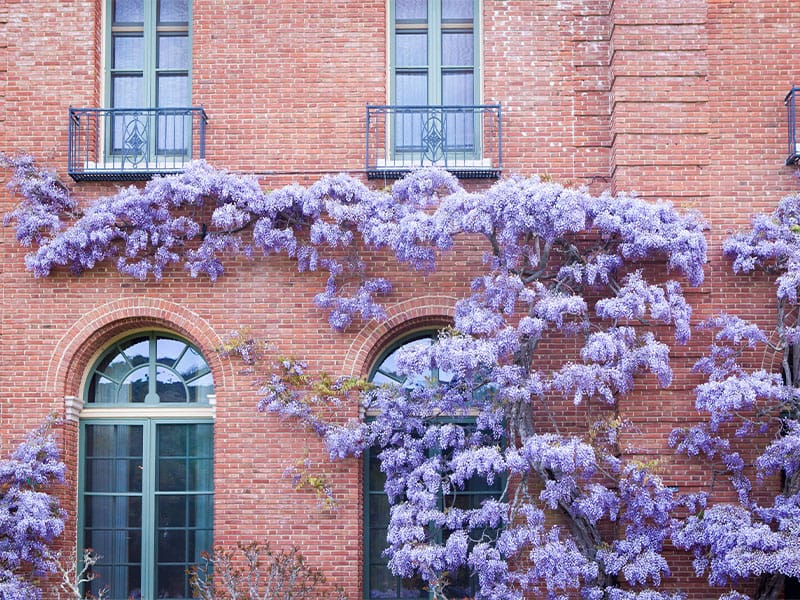
What about Water-Wisteria?
There is also an aquatic wisteria, so-called water wisteria. It belongs to the Acanthaceae family, and the plant has the botanical name of Hygrophila difformis. The water-wisteria is a different plant, and you shouldn’t associate it with Wisteria, a climbing plant.
How does Wisteria Look?
Wisteria has elongated foliage that grows in an alternate direction. Each leaf is long between six and 13 inches and has from nine to 19 leaflets. But, the flowers make the Wisteria so charming and give this plant a unique look.
The flowers grow in pendulous racemes, which can be from four to 32 inches long. There are purple, white, violet, and pink flowers, and it is hard to pick the prettiest one. But, the most common are purple flowers.
Wisteria has some similarities with the Golden chain tree (Laburnum), but the tree has yellow flowers. So far, there aren’t yellow Wisteria flowers, and it is the easiest way to differentiate the two plants.
Usually, Wisteria blossoms in spring once the leaves open. But, some species flower in late summer.
Also, some Wisteria species have heavily fragrant flowers.
Is Wisteria Toxic?
The Wisteria plant is poisonous. Seeds are most commonly ingested, but other parts of the plant also contain saponin wisterin. It is toxic for people and pets and causes nausea, confusion, dizziness, diarrhea, and other problems when ingested.
The toxicity category of the plant is 2 and 3. It means that the plant is potentially toxic and the severity of exposure determines the consequences. It is most harmful when ingested.
People don’t grow Wisteria in kindergartens, child care settings, etc. If you have children, make sure to restrict their access to the plant.
It can irritate skin and eyes with sticking hair and spines.
Wisteria is highly toxic to animals, especially dogs. If you suspect your dog ingested seeds seek the help of the veterinarian as soon as possible.
What does Wisteria Blossom Symbolize?
Wisteria is a long-living plant that can live for several centuries. In Japan, there is a plant that is 1200 old. So, it isn’t a surprise that Wisteria is a symbol of immortality and long life.
Because of its impressive beauty and longevity, Wisteria is a common immortality symbol in many cultures. It is common to print on sheets, too.
In Japan, the Wisteria plant stands for love, and the beautiful, toxic fragrance symbolizes sensuality, bliss, and sensitivity.
Because Wisteria can grow large to immense size, the plant symbolizes personal growth and expansion in some cultures.
What Varieties of Wisteria are there?
Wisteria varieties produce colorful curtains of flowers when grown properly, and it is challenging to choose the best variety.
The varieties differ not only by the flower look, but also by the growing rate, blooming season, fragrance, length of the flower cluster, and fall leaves.
Most of the Wisteria variations will blossom in the first couple of years after planting. I recommend you get familiar with the species rather than waiting for the plant to blossom to discover the variety.
Below, I summarize the most common varieties available of the Wisteria plant.
Chinese Wisteria
Chinese Wisteria or Wisteria Sinensis is one of the two most common varieties across the USA and eastern Asia. It is a potent climber, and the plant twins the stems counterclockwise. As it grows, it develops young elliptical or oval leaves in copper or bronze shade.
The flowers are scented and come in different violet shades, from blue-violet, violet, and warm shade of violet. Each flower grows on the 12 inches long raceme, and it attracts bees. The Chinese Wisteria blossoms in late spring or early summer and makes stunning flower curtains.
The ideal light condition for the Chinese Wisteria is full sun to partial shade.
Cultivars are available with white and violet flowers.
Japanese Wisteria
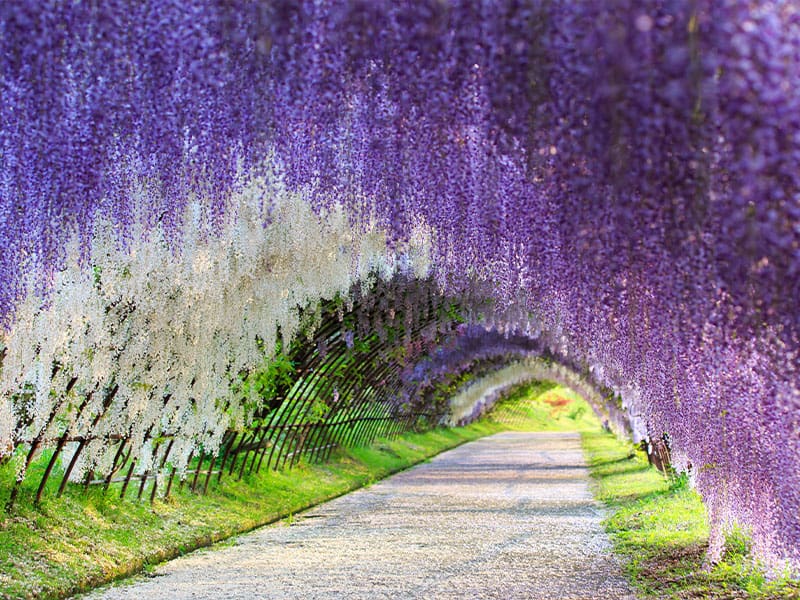
Wisteria Floribunda is popular under the name of Japanese Wisteria. It is like the Chinese one, but the stems twine clockwise. The young leaves are similar to the Chinese in shape and size, but the foliage is pale green and slowly turns yellow in the fall. The plant has long racemes of flowers that can reach about 4 feet! Japanese Wisteria has extended blooming season and looks beautiful in the fall as well.
The plant requires full sun exposure to grow to its full potential and needs pruning and care more than some other species.
It comes mostly with different violet flowers, but some Japanese cultivars have delicate white and pink flowers, too.
Silky Wisteria
Silky Wisteria also comes from Japan and is known for its botanical name Wisteria brachybotrys or Wisteria venusta. The stems braid anticlockwise around available support.
It got its name by the silky hair on leaflets and has strongly scented flowers. The racemes are short, around 6 inches, and blossoms in the full sun in late spring.
There are cultivars with violet, pink and white flowers and dense foliage.
American Wisteria
The American Wisteria or Wisteria frutescens has leaves with up to 15 leaflets. The plant looks simple, compared to the Asian varieties, and it isn’t as popular as them. Because the plant is less invasive, it can be an excellent choice for smaller places.
Each raceme can hold up to 65 small flowers.
Kentucky Wisteria
Wisteria macrostachya or Kentucky Wisteria is a slim and charming variety with stems twining counterclockwise. Each leaf can hold up to 11 leaflets, and the flowers are moderately scented.
The racemes are rich with up to 80 flowers and appear later in the season. It can be grown on wet soil and is relatively easy to control. Too bad people don’t grow it so much nowadays.
How to Grow Wisteria?
Growing Wisteria requires good preparation in terms of location and time of planting. Let me guide you through the complete process of growing Wisteria and making it blossom.
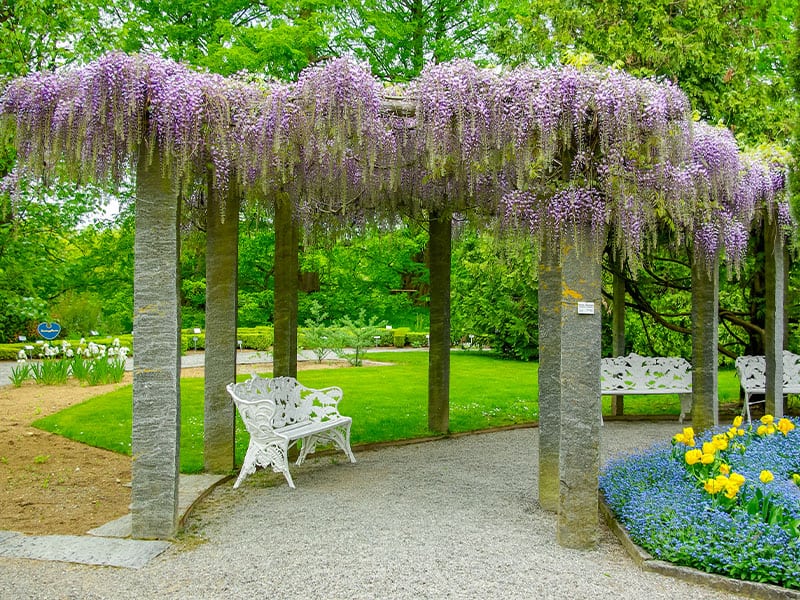
When to Plant Wisteria?
The ideal time to plant your Wisteria is spring or fall when the plant is dormant. You can grow Wisteria from seeds, but I don’t recommend it. It will take several years for the plant to mature and blossom.
If you buy an established Wisteria plant, it will produce flowers much sooner. The alternative is growing it from the cuttings.
You can grow it in zones 3 to 9.
Where to Plant Wisteria?
The location is very important for growing Wisteria and producing flowers. The ideal location for your plant is where it can get up to six hours of sun per day. If you ensure a sunny spot for your plant, training it to grow to the desired shape and blossoming will be much effortless.
However, if you have a colder climate, I recommend planting Wisteria in partial shade and sheltered locations. The hard spring frost can damage flower buds and affect the blossom.
The plant prefers moist, fertile, and well-draining soil. If you suspect that the soil in your garden is of poor quality, you can amend the soil with compost.
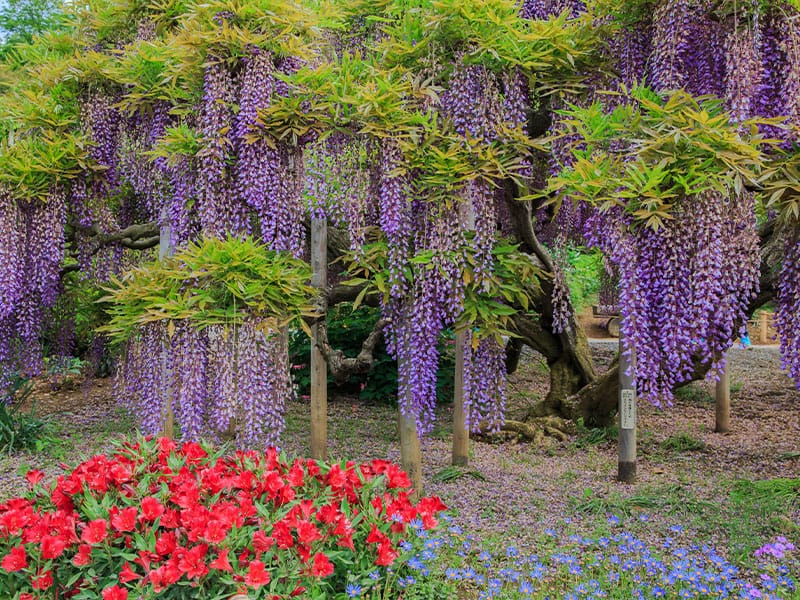
Additionally, the plant slowly overtakes the nearby structures – sheds, homes, garages, etc. Avoid planting Wisteria too close to your house!
But, twining stems need structure to climb. You can use wooden trellis or metal and the pergola will work too. Make sure that the structure is sturdy because grown-up wisteria can be heavy.
How to Plant Wisteria?
The process is relatively simple. You can start by digging the hole twice wider than the plant’s root ball and around the same depth. Then, put the plant in the hole and align it with the soil line.
Repeat the process for as many root balls as you have, but separate the plants at least 10 feet. As the plants develop, they will fill in the blank space.
Wisteria doesn’t require too much care during the first year. All you have to do is water the roots regularly. Don’t worry if your plants slowly wake up, the plant requires time to establish and a couple of years to flower.
Does Wisteria Need Fertilizer?
If the soil is good quality and well-draining, your Wisteria needs little fertilizer.
You can apply nitrogen-based fertilizer to help the vegetative growth, but it won’t affect the blossom. In average acid soil with a pH level between 6 and 7, you can apply the fertilizer once a year.
What about Compost and Mulch?
A layer of compost and a double layer of mulch are helpful for the plants. It will help the plant retain moisture and keep the weeds away.
How Much Water Wisteria Needs?
The average water needs of Wisteria are one inch per week. Therefore, you can water your plants during the drought season, because most likely, the Wisteria will get enough water from rain during other seasons.
If you are a beginner, there is a convenient tip you can apply to track water levels. Placing the empty can outside and tracking the level of water with a measuring stick will give you insights into how much rain your plants got that week. Also, you can check the forecast data.
Don’t forget to water the plant at the soil level, to prevent diseases.
Pruning
Pruning is one of the most important steps to grow the most beautiful Wisteria vines. Wrong pruning can destroy all your previous efforts and leave your Wisteria without flowers.
A well-established pruning routine will result in the most beautiful flowers and give you the magical effect you expect from Wisteria.
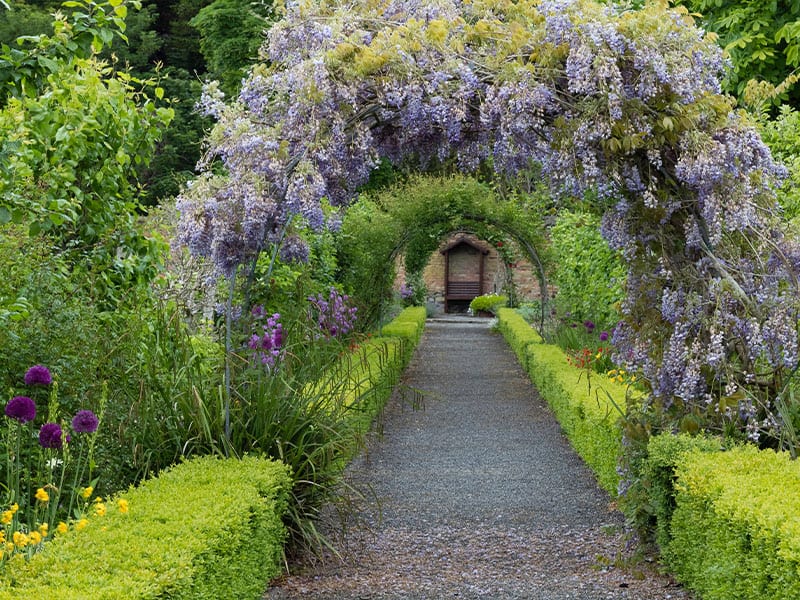
When to Prune Wisteria?
Once you planted Wisteria, you should prune it when it climbs to the wall or the structure you prepared. Once you notice that it covered the structure, you should start your pruning routine.
You should prune Wisteria twice a year. First of all, prune the plan in mid-summer, July or August and reduce the whippy growth. Shorten the plant to around 1 foot and five to six leaves. It will allow the wood to ripen and encourage the plant to form flower buds.
Next year, in February, you can reduce the shoots to around two or three buds and 4 inches in length. That way, you will prepare the plant for the blooming season and create a tidy display for new flowers.
What is Hard Pruning?
Hard pruning refers to pruning old plants to reinvigorate old plants and deal with the upholding structure. It comes down to removing old growth, branches that grow over windows and doors.
Sometimes, you need to drastically change the look of Wisteria by shortening long branches to the half and removing large sections of old-growth. In some cases, to change the look and train the plant again, you need to cut all the way back to the main branch or ground level.
Hard pruning needs to be planned and done carefully, especially when you have to cut thick branches.
Benefits of hard pruning:
- It will inhibit new growth, stronger and the plant will be stronger than before. Therefore, avoid spring fertilizing in the year when you want to prune Wisteria.
- If you don’t like the previous framework, you can train new branches to grow in the shape you want
- You can remove old, unnecessary branches and improve the look of the plant
The hard pruning timing is between fall and early February. Once you complete it, you can continue with your standard pruning routine, and prune the plant twice a year.
Training Wisteria for Most Beautiful Displays
There are different ways you can train Wisteria to grow to your desired shape and look. Let’s see what the most attractive structures are.
Growing on the Wall
When Wisteria covers the wall, it creates a wonderful, organic facade and builds a strong supporting system. It takes years to achieve it, but you will be happy with the results. The plant also requires regular maintenance to avoid going over the windows and doors.
The simplest way to achieve it is to use horizontal support wires made from galvanized steel. Pick the wires 3 mm thick and set them 1 foot apart from each other. The plant will twine around the wires and develop a strong network of its branches.
Over time, you will have to cut new shoots at the base to maintain a tidy look.
On Arches
My favorite structure for Wisteria is the arch. You can plant it at the base of the arch and prune the racemes regularly to ensure the remaining flowers have enough space.
Flower racemes hanging free on the hidden arch will look stunning in every garden!
Train Wisteria around Free Standing Tree
You can also train the plant to grow into a small tree, but it will affect the health of the supporting tree.
Training it to grow around the large tree is challenging and may affect the Wisteria blossom.
You should plant Wisteria on the south side of the chosen tree, approximately 3 feet away from the trunk.
Can you Grow Wisteria in Pots?
Even though Wisteria grows best when planted in soil outside, you can also grow it in containers, indoors. When you grow the plant indoors, it is easier to control the soil moisture level and prune the plant to the desired shape.
Also, the plant is at fewer risk of drying.
Let’s see how to grow Wisteria in pots indoors.
Choose the Right Size Container
Wisteria is a large plant and invasive one. You will have to choose a large, sturdy, commercial-grade container that can hold the heavy vine and supporting structure. The material of the container is also important. I
recommend using stone or ceramic because they hold the moisture level excellent and maintain soil temperature.
Because you will have to move your plant outdoors to get at least six hours of sun, pick the container you will be able to handle.
Pick the container that is four sizes larger than the one you got your plant in. Therefore, you will have enough time to pick the permanent container as the plant slowly establishes in the temporary one.
Supporting Structure
Growing Wisteria requires a supporting structure in the container just like in the soil. A supporting structure will help the blooms but also helps you train the plant to grow in the vertical direction.
You can use wood stakes within the container. If you want to train the plant to cover the wall, you can place the container against the wall and attach wire rows on the wall.
Growing Wisteria in containers requires a lot of care and maintenance. You need to prune it regularly, even more often than the plant in the garden, to make it fit the container and control the growth.
Why Won’t Wisteria Produce Flowers?
Maybe you have done everything from planting to pruning and waited for a couple of years, but Wisteria won’t bloom. What can be the problem?
Nitrogen and Improper Fertilization
Most likely, the problem is nitrogen. When a plant gets too much nitrogen, the foliage growth increases, so no energy goes to producing flower buds.
Another issue is the improper timing of the fertilization. Sometimes, fertilizing in the spring improves foliage, but slows down the blooming process.
The Plant is too Young
Wisteria needs from five to seven, sometimes even 14 years to get mature enough and blossoms. When you buy the plant from the nursery, you can expect the blossoms in the first couple of years. But, if you decide to grow the plant from the seeds, be ready to wait a decade.
The Plant Doesn’t Get Enough Sun
Additionally, if the plant doesn’t get enough sun, the flowers won’t develop. Therefore, choosing a permanent location for the plant is vital for future blossoms.
How to Make Wisteria Blossom?
To identify if nitrogen is the problem, you can add phosphorus to the soil. Amend the soil with phosphate-based fertilizer and that should be it.
An alternative way to do it is to root prune Wisteria. It is a more complex technique and requires a shovel. Dig a hole around the roots and shorten them to a maximum of 3 feet from the main trunk. If you over prune the roots, you can kill the plant.
If phosphorus fertilizer and root prune don’t solve your problems, maybe the plant doesn’t get enough sun or you fertilize it in the spring? Give your plant time to develop flower buds and be persistent, because it will pay out once you see the beautiful flower curtain.
Pests and Diseases
Wisteria is a resilient plant that contributes to its popularity. The serious issues with this plant are rare, but some problems can be fatal to the plant.
Let’s discuss the most common issues with the Wisteria plant.
Fungal Diseases
Powdery mildew or fungal leaf disease can occur occasionally. You will notice fungi problems by small yellow spots on the foliage or white coating on the leaf.
It slowly spreads across the plant. But, sometimes affected leaves turn brown with holes and destroy the pleasant look of the Wisteria vine.
The only way to avoid fungi diseases is to ensure airflow in the plant structure by pruning the plant. When the fungi have overtaken the plant, you can use neem oil after you thinned the canopy.
Root Problems
Fungi cause minor problems, but the root and crown problems can leave severe consequences on the plant.
Once you notice that your plant is slowly collapsing and wilting, it means that the plant doesn’t get enough nutrients from the root system. You can also recognize swollen knots, sunken areas, etc. You may cut the knots from the branches, but if the disease affected most of the plant, there is no cure.
Pests
You need to identify insects around the plant to control them. The most common insects that can attack Wisteria are aphids, long-horned borers, and scales.
Aphids come in different colors and are tiny, soft-bodied insects. These insects have a narrow shape and long antennae and are essentially beetles.
Scales have one wing pair and a delicate look.
If you manage to identify the insect type, find the appropriate insecticide to control it, and always follow the manufacturer’s recommendations for use. If you cannot identify the insects, try with an all-purpose insecticide spray, but it will take more time to stop the infestation.
Also, don’t forget to remove infested parts and remove dead leaves and branches. Keep the plant healthy, and avoid keeping firewood around it, as beetles can come to the plant for feeding.
When you use insecticide, apply it around the trunk.
Persistence Pays Off
Wisteria is one of the most wonderful flowering plants. It requires regular care in terms of pruning, but if you find the proper location, it gets pretty simple.
However, you should be patient and persistent, and avoid rushing the plant to blossom. Only mature plants can produce flower buds, and sometimes it can take up to ten years to see your effort paying out.
But, if you buy the established plant from the nursery, you don’t have to wait for that much. Excellent sun exposure and regular pruning are essential to making your Wisteria blossom!
How did you like my Wisteria guide? Don’t forget to like and share the guide if you liked it? Which plants would you like me to cover next?
